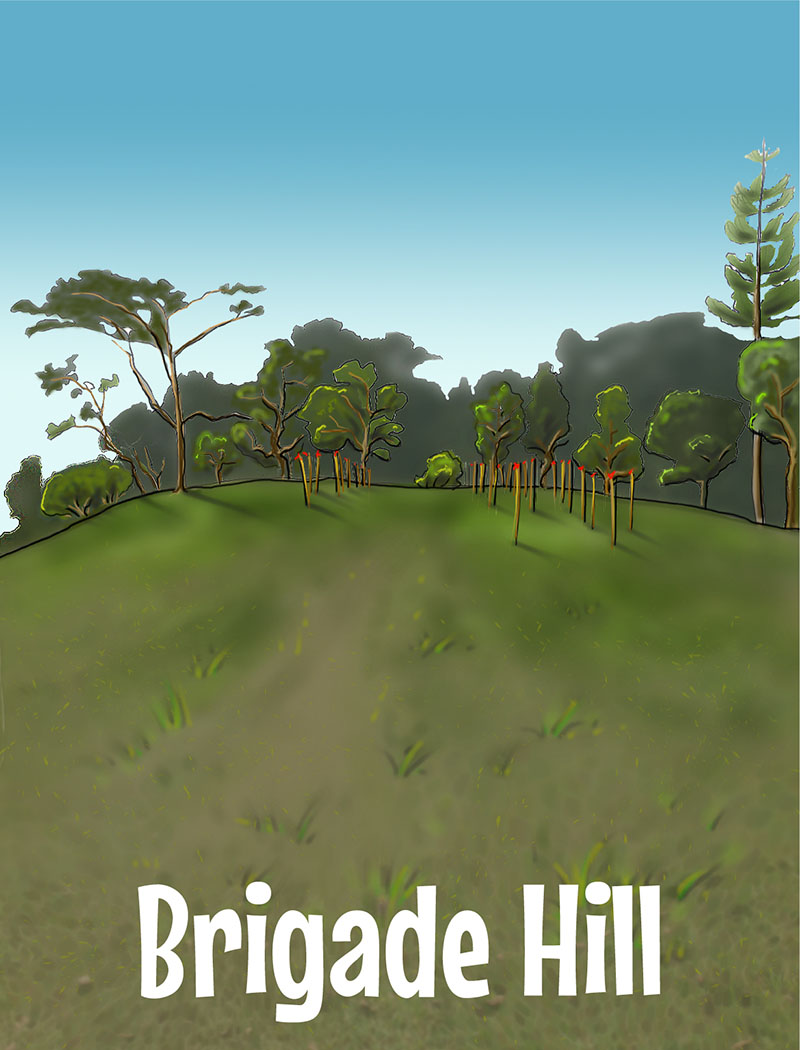6th September to 8th September 1942
Brigade Hill was the site of one of the most intense battles of the campaign along the Kokoda trail. Other than this, there were two holding actions at Kokoda and Deniki, plus major actions at Isurava and Ioribaiwa Ridge.
Brigade Hill later became a cemetery. The graves have now been moved to Bomana cemetery. Sticks have been placed in the ground on Brigade Hill to mark the original graves.
By the time they got to Brigade Hill, the Australians were weakened by two weeks of savage fighting and three weeks of exhausting marching over rugged terrain, exposure and lack of supplies and sleep. They were down to less than half their strength.
This was the only time Brigadier Potts had his whole Brigade together at one time and place.
When dusk fell on 6 September the Australians saw an unnerving site: coming down the other hill towards the valley were hordes of Japanese soldiers. The Australians could only sit there watching the approach in silence.
Over 1500 enemy troops came along the track. This was the main attacking force. Many more were out of sight following the standard Japanese outflanking movements. Many other Japanese would be coming up as reinforcements. This enemy force clearly outnumbered the 1170 Australians on Mission Ridge and Brigade Hill.
By mid-morning of 7th September Japanese patrols began probing the Australian lines with intermittent fire and long-range mortar, heralding the commencement of the battle at Brigade Hill.
The Japanese command ordered their troops to encircle the Australian flanks, and they continued their stealthy movements into the night. They followed the base of the cliffs, covering an enormous amount of ground during the night.
Before dawn of 8 September the Japanese began their long-anticipated attacks. It is a day that will be remembered as one of the most bitterly intense and costly actions fought by Australian troops.
Climbing up the ridge before dawn, they were able to lodge themselves on the track in the vicinity of where the cleared knoll/plaque is now located (see image on page 18 of the book), behind the three battalions at the front but in front of Brigadier Potts’ Headquarters at the back.
Headquarters was critical to the coordination of the brigade’s actions. It also held all the reserves of food and ammunition as well as the responsibility of guarding the main track to the rear. It was now cut off from its forward battalions and the Australian soldiers were trapped.
Headquarters were supposed to be the furthest from the action. At first light on 8 September Brigadier Potts was anticipating a quiet moment to himself. It was not to be. A shot rang out from a Japanese sniper and sent Potts scurrying for cover. It caused grave concern among the whole Headquarters Company, whose members immediately found themselves engaged by the Japanese with rifle fire and grenades.
The companies at the front bore the brunt of the attacks. Rifle fire, grenades and automatic weapons beat the Japanese back, but the day’s fighting was so intense that by nightfall six of the prize Bren guns had been knocked out. The company’s entire supply of 1200 grenades, the battalions reserve supply of grenades, as well as 100 rounds of ammunition per man were exhausted.
By this stage the enemy was well dug in. They used single-man trenches, they were also hidden behind logs and had snipers in trees, while machine guns supported the infantrymen. Horrific casualties were incurred. Some Australian soldiers managed to scramble through without being hit. Others were overwhelmed and lay slain beside the track, one of whom was Charlie McCallum. (Subscribe to our emails to find out more about Charlie McCallum)
Brigadier Potts called for a near-suicide mission: an attempt to reach his three battalions trapped on Brigade Hill. He called for some of his men to attack up the track from the headquarters position. A group of 12 men agreed to go. Captain Langridge, of D company, unquestioningly and calmly handed his pay book to a friend. He then stood turned and moved forward, beckoning the men to follow. Within minutes many of them were killed.
As darkness fell Japanese pressure eased just enough to enable Potts and his company to fall back along the main track to Menari. Under the cover of darkness and with the main track still in the hands of Japanese, the forward battalions moved from their positions on the ridge to a very narrow, steep and closed-in track to reach Menari by a more circular route. They fought a rear-guard action, on occasions pushing back in short sharp attacks on the Japanese to confuse them and slow their advance.
The battle of Brigade Hill and the subsequent withdrawal cost the Australians: 60 men killed in action and two deaths from wounds. Despite the large loss of life, the trauma of battle, the horrendous suffering of the wounded, and the physical and mental exhaustion, morale remained high. Wisecracks flowed freely except when absolute silence was necessary. The weakest jokes never failed to raise a smile from hollow stubbly cheeks.



